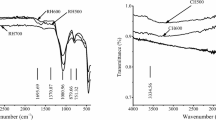Abstract
Batch adsorption experiments were carried out to evaluate the effect of type of crop residues and chemical pretreatment solutions on the removal efficiency of heavy metal ions at different concentrations of synthetic wastewater solutions. Rice straw, cotton stalks, and maize stalks were pretreated with different solutions (i.e., sulfuric acid, oxalic acid, sodium hydroxide, and distilled water as the control treatment) in order to increase their metal-binding capacity. Results indicated that cotton stalks were the best biosorbent material according to their efficiency in removal of heavy metal ions. Sodium hydroxide was the best chemical pretreatment method for stimulating the biosorption capacity of crop residues. Ions of Pb2+ had the highest biosorption ratio among all competitive ions, whereas Mn2+ ions had the lowest. The removal efficiency decreased as the concentration of heavy metal ions increased in aqueous solutions. Sorption equilibrium isotherms could be described by the Langmuir model in most cases, whereas an isotherm of S shape was observed in other cases, which did not follow the Langmuir isotherm model. In conclusion, cotton stalks pretreated with sodium hydroxide could be used as an efficient technique for wastewater remediation prior to irrigation due to its low-cost, little processing, and high biosorption capacity.






Similar content being viewed by others
References
Ahluwalia, S. S., & Goyal, A. D. (2007). Microbial and plant derived biomass for removal of heavy metals from wastewater—a review. Bioresource Technology, 98, 2243–2257.
Amuda, O. S., Giwa, A. A., & Bello, I. A. (2007). Removal of heavy metal from industrial wastewater using modified activated coconut shell carbon. Biochemical Engineering Journal, 36, 174–181.
Ayers, R. S., & Westcot, D. W. (1985). Water quality for agriculture. Irrigation and Drainage Paper No.29, FAO, Rome.
Basso, M. C., Cerrella, E. G., & Cukierman, A. L. (2002). Lignocellulosic materials as potential biosorbents of trace toxic metals from wastewater. Industrial & Engineering Chemistry Research, 41, 3580–3585.
Celik, A., & Demirbas, A. (2005). Removal of heavy metal ions from aqueous solutions via adsorption onto modified lignin from pulping wastes. Energy Sources, 27, 1167–1177.
Demirbas, A. (2000). Biomass resources for energy and chemical industry. Energy Education Science and Technology, 5, 21–45.
Feng, N., Guo, X., & Liang, S. (2010). Enhanced Cu (II) adsorption by orange peel modified with sodium hydroxide. Transactions of Nanoferrous Metals Society of China, 20, 146–152.
Guo, X., Zhang, S., Shan, X. Q., Luo, L., Pei, Z., Zhu, Y. G., et al. (2006). Characterization of Pb, Cu, and Cd adsorption on particulate organic matter in soil. Environmental Toxicology and Chemistry, 25, 2366–2373.
Harrison, R. M., & Laxen, D. P. H. (1984). Lead pollution: Causes and control. London: Chapman and Hall.
Kumar, U., & Bandyopadhyay, M. (2006). Sorption of cadmium from aqueous solution using pretreated rice husk. Bioresource Technology, 97, 104–109.
Mehrasbi, M. R., Farahmandkia, Z., Taghibeigloo, B., & Taromi, A. (2009). Adsorption of lead and cadmium from aqueous solution by using almond shells. Water Air and Soil Pollution, 199, 343–351.
Nakajima, A., & Sakaguchi, T. (1990). Recovery and removal of uranium by using plant wastes. Biomass, 21, 55–63.
Nigam, S. N., & Pandey, A. (2009). Biotechnology for agro-industrial residues utilisation: Utilisation of agro-residues. New York: Springer. LLC.
Ozer, A., & Pirincci, H. B. (2006). The adsorption of Cd (II) ions on sulphuric acid-treated wheat bran. Journal of Hazardous Materials, 137, 849–855.
Qaiser, S., Saleemi, A. R., & Ahmad, M. M. (2007). Heavy metal uptake by agro based waste materials. Environmental Biotechnology, 10, 409–416.
Rehman, H., Shakirullah, M., Ahmad, I., & Sheshah, H. (2006). Sorption studies of nickel ions onto sawdust of Dalbergia sissoo. Journal of the Chinese Chemical Society, 53, 1045–1052.
Saygideger, S., Gulnaz, O., Istifli, E. S., & Yucel, N. (2005). Adsorption of Cd(II), Cu(II) and Ni(II) ions by Lemna minor L.: Effect of physicochemical environment. Journal of Hazardous Materials, 126, 96–104.
Schiewer, S., & Patil, S. B. (2008). Pectin-rich fruit wastes as biosorbents for heavy metal removal: Equilibrium and kinetics. Bioresource Technology, 99, 1896–1903.
Senesi, N., Sposito, G., & Bradford, R. (1989). Iron, copper, and manganese complexation by forest leaf litter. Forest Science, 35, 1040–1057.
Srivastava, S. K., Singh, A. K., & Sharma, A. (1994). Studies on the uptake of lead and zinc by lignin obtained from liquor—a paper industry. Environmental Science and Technology, 15, 353–361.
Sud, S., Mahajan, G., & Kaur, M. P. (2008). Agricultural waste material as potential adsorbent for sequestering heavy metal ions from aqueous solutions—a review. Bioresource Technology, 99, 6017–6027.
Suzuki, Y., Kametani, T., & Maruyama, T. (2005). Removal of heavy metals from aqueous solution by nonliving Ulva seaweed as biosorbent. Water Research, 39, 1803–1808.
Tüzen, M. (2003). Determination of heavy metals in soil, mushroom and plant samples by atomic absorption spectrometry. Microchemical Journal, 74, 289–297.
Volesky, B. (1990). Biosorption of heavy metals. Boca Raton: CRC.
Volesky, B. (2007). Biosorption and me: A review. Water Research, 41, 4017–4029.
Wan Nagh, W. S., & Hanafiah, M. A. K. M. (2008). Removal of heavy metal ions from wastewater by chemically modified plant wastes as adsorbents: A review. Bioresource Technology, 99, 3935–3948.
Acknowledgments
Authors would like to acknowledge both of the German Academic Exchange Service (DAAD) and the Egyptian Ministry of Higher Education represented in Science and Technology for Development Fund (STDF) for the financial support. Authors also would like to acknowledge Mrs. Petra Grossman and all other technicians in the Institute of Soil Science and Forest Nutrition, Freiburg University, Germany for their help and support.
Author information
Authors and Affiliations
Corresponding author
Rights and permissions
About this article
Cite this article
Mosa, A.A., El-Ghamry, A. & Trüby, P. Chemically Modified Crop Residues as a Low-Cost Technique for the Removal of Heavy Metal Ions from Wastewater. Water Air Soil Pollut 217, 637–647 (2011). https://doi.org/10.1007/s11270-010-0616-5
Received:
Accepted:
Published:
Issue Date:
DOI: https://doi.org/10.1007/s11270-010-0616-5




